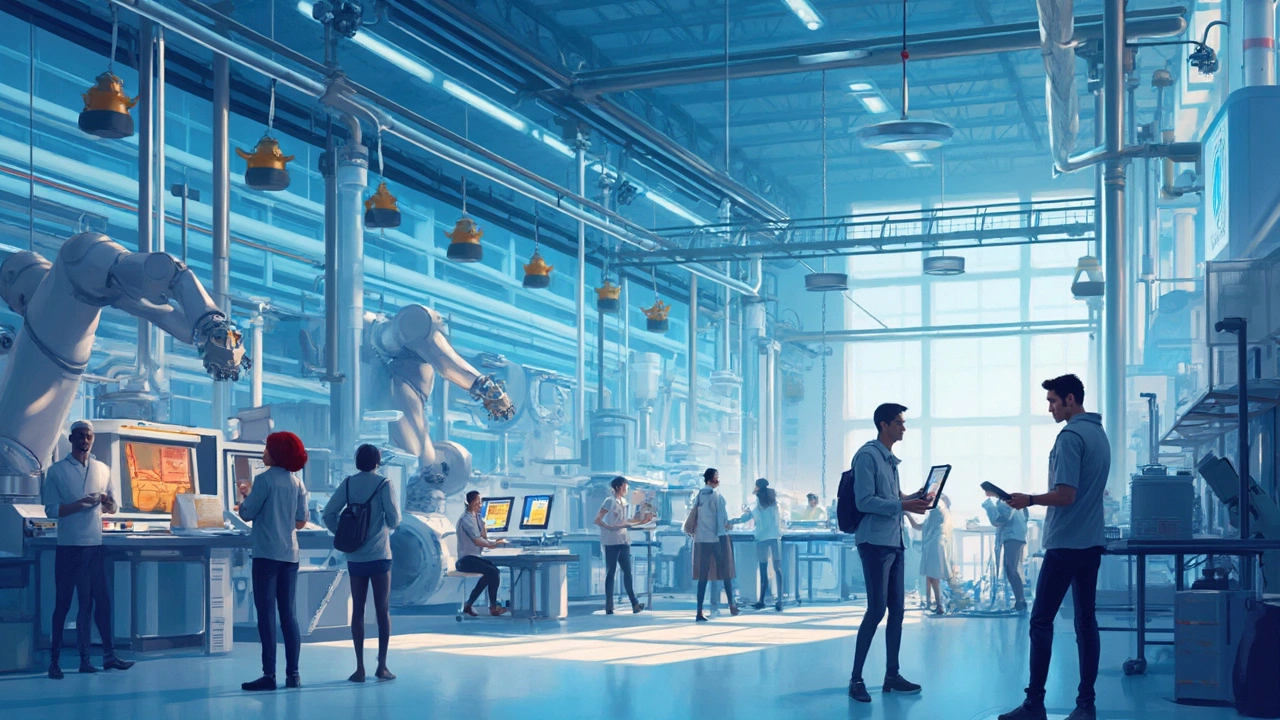So, is there really a manufacturing boom happening in the US, or are we just buying into some well-marketed hype? This thing kicks off with all the chatter about government schemes, which have made some solid changes—nothing revolutionary but enough to stir the pot. With incentives and push for 'Made in America,' there's definitely energy in the air.
Let's talk straight. One interesting fact is that the government has rolled out initiatives like the reshoring tax breaks, which encourage companies to bring manufacturing back home. And yeah, it's working to some extent, but companies are also dealing with stuff like labor shortages and fierce competition from international markets. They're not just sitting back and cashing in.
On the tech front, AI and automation are shaking things up. Factories aren't what they used to be—they're cleaner, smarter, and yes, even a bit more futuristic. But the transition is a work in progress, not a full-on sci-fi makeover. Keep reading and we'll dive deeper into what’s really going on.
- Current State of US Manufacturing
- Government Schemes and Their Impact
- Technological Advancements
- Challenges in the Industry
Current State of US Manufacturing
Right now, the US manufacturing scene is a mixed bag of opportunities and hurdles. There's definitely some action, thanks in part to those government schemes we talked about—not to mention a growing consumer demand for locally made stuff. But let’s break it down a bit.
Production Trends
After a shaky few years, production levels have picked up, with certain sectors like electronics and automotive seeing a solid uptick. More companies are looking to bring operations back to American soil. You've got this mix of big names and smaller niches doing their thing and trying to grab a larger slice of the pie.
Employment Landscape
There's been a steady but slow rise in manufacturing jobs. The trouble is the gap between what's needed and the available skilled workforce. Companies are reaching out through tech schools and vocational training, but it's a slow climb.
Key Statistics
| Year | Manufacturing Jobs (Millions) | Value of Manufactured Goods (Trillions) |
|---|---|---|
| 2020 | 11.4 | 2.3 |
| 2024 | 12.3 | 2.6 |
As you can see, there's a positive trend, but it honestly needs to be a little steeper if we're going to shout about a genuine manufacturing boom.
Regional Growth
But hey, some areas are doing better than others. The Midwest, long considered the heartland of manufacturing, is still leading the pack. But down South, places like Texas and Tennessee are getting in on the game, credit to cheaper labor and a supportive business climate.
Overall, the current state is promising but cautious. It's like we're setting the scene for a boom; whether it's big or just a sizzle depends on how these factors play out. Stick around as we explore more layers!
Government Schemes and Their Impact
When it comes to the US manufacturing scene, the government schemes play a pretty big role. They're designed to give a boost to local industries and keep jobs and production right here on American soil. One major push is the reshoring tax incentives which encourage companies to bring their manufacturing operations back to the US. This move not only helps revive the industry but also strengthens the economy by creating jobs.
But there's more on the table. The government has been funding a bunch of training programs aimed at bridging the skills gap that many US manufacturers are facing. These programs prepare workers with the skills they need to operate the new tech filling modern factories.
What's in the Bill?
Part of the plan includes tax breaks and subsidies for adopting green technologies. This is a big deal because cleaner, more efficient technologies can reduce costs and environmental impact, making the US more competitive on the global stage.
Moreover, some of these schemes focus specifically on small and medium-sized enterprises (SMEs). Recognizing their critical role in the economy, the government is making efforts to ensure these businesses get enough support to innovate and expand.
Real Numbers, Real Impact
These initiatives have shown some impressive results so far. Here’s a snapshot:
| Year | Jobs Created | Manufacturing Output ($ Billion) |
|---|---|---|
| 2022 | 150,000 | 2,300 |
| 2023 | 175,000 | 2,450 |
| 2024 | 190,000 | 2,600 |
These figures highlight the tangible impact of these government schemes on the US manufacturing boom. While these numbers are encouraging, it's crucial to keep monitoring their long-term effects for sustained growth.
To sum it up, while no scheme is a silver bullet, these efforts collectively push the US manufacturing industry towards a promising future, filled with opportunities and challenges in equal measure.

Technological Advancements
Technological upgrades are a pretty big deal in today's US manufacturing scene. Factories are looking less like dusty warehouses and more like sleek high-tech hubs, thanks to both automation and the introduction of AI in production lines. So, what's really changing on the ground?
Robots and Automation
One of the biggest changes has been the adoption of robots on the factory floor. These aren't your typical sci-fi movie robots—more like really efficient machines that don't need breaks. Companies are using them for everything from assembly to quality checks. This boosts efficiency and drives down mistakes, making the overall process faster.
AI's Role in Manufacturing
AI isn't just for your smartphone or computer. In manufacturing, it's used for things like predictive maintenance. Basically, it helps foresee equipment issues before they even happen, cutting down unexpected downtime. Plus, with AI, manufacturers can analyze tons of data to improve their process, tailoring products like never before.
The IoT Revolution
The Internet of Things (IoT) is making factories smarter. Machines now talk to each other and share data, creating a more connected and responsive production line. This allows for better track of inventory, monitoring of equipment health, and even energy management, which is huge if you're thinking about sustainability.
| Year | Percentage Increase in Automation |
|---|---|
| 2020 | 15% |
| 2023 | 25% |
| 2025 | 35% |
While things look promising, there's a clear need for retraining the workforce to work alongside these advancements. Companies are stepping up with training programs, but it's a work in progress.
There's still a long way to go until the full potential of these advancements is seen in everyday life, but the gears are certainly in motion. The manufacturing boom in the US could majorly benefit as these tech advancements evolve further, creating a symbiotic relationship between humans and machines.
Challenges in the Industry
Let's get real about what's holding back the US manufacturing boom. Despite the government's efforts and the cool tech coming into play, there are some big hurdles.
Labor Shortages
Finding skilled workers is a headache for many companies. The manufacturing sector has this reputation—totally outdated but still sticking around—of being less attractive to young folks. Many just don't see it as a cool career path. On top of that, many older workers are retiring, creating a talent gap that's hard to fill.
Global Competition
The US isn't the only one in the race. Countries like China and Germany are major players in manufacturing, and their costs are often way lower. While US factories are trying to cut down costs through automation, keeping up with these big competitors is no easy feat.
Supply Chain Woes
The supply chain is still recovering from the recent global shake-ups. While things are better, there are hiccups that slow down production and increase costs. Whether it's parts or raw materials, any delay can mess up the whole operation.
Regulatory Hurdles
There's also a thick layer of regulations. While important for safety and environment, they can slow down operations or increase costs. Navigating through the bureaucracy requires time and resources that small to medium enterprises might not have on hand.
Technological Adaptation
Adopting new technologies isn't just plug-and-play. The shift to more automated systems requires investment and training that not every company can afford. Smaller businesses often lag behind and can't enjoy the same efficiency boosts.
The manufacturing industry is loaded with both opportunities and challenges. Tackling these hurdles is a must for the US to truly see a robust and sustained boom.











Write a comment